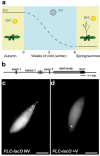Insights into chromatin structure and dynamics in plants
- PMID: 24833230
- PMCID: PMC4009787
- DOI: 10.3390/biology2041378
Insights into chromatin structure and dynamics in plants
Abstract
The packaging of chromatin into the nucleus of a eukaryotic cell requires an extraordinary degree of compaction and physical organization. In recent years, it has been shown that this organization is dynamically orchestrated to regulate responses to exogenous stimuli as well as to guide complex cell-type-specific developmental programs. Gene expression is regulated by the compartmentalization of functional domains within the nucleus, by distinct nucleosome compositions accomplished via differential modifications on the histone tails and through the replacement of core histones by histone variants. In this review, we focus on these aspects of chromatin organization and discuss novel approaches such as live cell imaging and photobleaching as important tools likely to give significant insights into our understanding of the very dynamic nature of chromatin and chromatin regulatory processes. We highlight the contribution plant studies have made in this area showing the potential advantages of plants as models in understanding this fundamental aspect of biology.
Figures




Similar articles
-
Histone H3 and H4 tails play an important role in nucleosome phase separation.Biophys Chem. 2022 Apr;283:106767. doi: 10.1016/j.bpc.2022.106767. Epub 2022 Feb 2. Biophys Chem. 2022. PMID: 35158124 Free PMC article.
-
Histone variants: the artists of eukaryotic chromatin.Sci China Life Sci. 2015 Mar;58(3):232-9. doi: 10.1007/s11427-015-4817-4. Epub 2015 Feb 14. Sci China Life Sci. 2015. PMID: 25682395 Review.
-
Histone variants: key players of chromatin.Cell Tissue Res. 2014 Jun;356(3):457-66. doi: 10.1007/s00441-014-1862-4. Epub 2014 Apr 30. Cell Tissue Res. 2014. PMID: 24781148 Review.
-
Electron spectroscopic tomography of specific chromatin domains.Methods Mol Biol. 2013;1042:181-95. doi: 10.1007/978-1-62703-526-2_13. Methods Mol Biol. 2013. PMID: 23980008
-
Lateral Thinking: How Histone Modifications Regulate Gene Expression.Trends Genet. 2016 Jan;32(1):42-56. doi: 10.1016/j.tig.2015.10.007. Epub 2015 Dec 17. Trends Genet. 2016. PMID: 26704082 Review.
Cited by
-
MarpoDB: An Open Registry for Marchantia Polymorpha Genetic Parts.Plant Cell Physiol. 2017 Jan 1;58(1):e5. doi: 10.1093/pcp/pcw201. Plant Cell Physiol. 2017. PMID: 28100647 Free PMC article.
-
The diverse and unanticipated roles of histone deacetylase 9 in coordinating plant development and environmental acclimation.J Exp Bot. 2020 Oct 22;71(20):6211-6225. doi: 10.1093/jxb/eraa335. J Exp Bot. 2020. PMID: 32687569 Free PMC article. Review.
-
Tidying-up the plant nuclear space: domains, functions, and dynamics.J Exp Bot. 2020 Aug 17;71(17):5160-5178. doi: 10.1093/jxb/eraa282. J Exp Bot. 2020. PMID: 32556244 Free PMC article. Review.
-
A Multigraph-Based Representation of Hi-C Data.Genes (Basel). 2022 Nov 23;13(12):2189. doi: 10.3390/genes13122189. Genes (Basel). 2022. PMID: 36553456 Free PMC article.
-
Genome-wide analysis of bromodomain gene family in Arabidopsis and rice.Front Plant Sci. 2023 Mar 8;14:1120012. doi: 10.3389/fpls.2023.1120012. eCollection 2023. Front Plant Sci. 2023. PMID: 36968369 Free PMC article.
References
Grants and funding
LinkOut - more resources
Full Text Sources
Other Literature Sources

